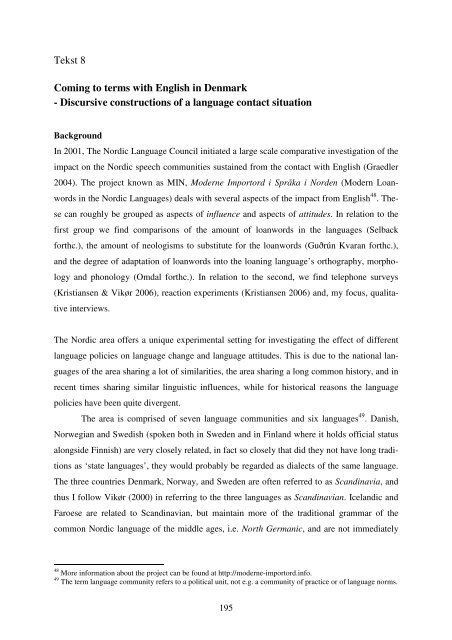Hør dog hvad de siger - Note-to-Self: Trials & Errors
Hør dog hvad de siger - Note-to-Self: Trials & Errors
Hør dog hvad de siger - Note-to-Self: Trials & Errors
Create successful ePaper yourself
Turn your PDF publications into a flip-book with our unique Google optimized e-Paper software.
Tekst 8<br />
Coming <strong>to</strong> terms with English in Denmark<br />
- Discursive constructions of a language contact situation<br />
Background<br />
In 2001, The Nordic Language Council initiated a large scale comparative investigation of the<br />
impact on the Nordic speech communities sustained from the contact with English (Graedler<br />
2004). The project known as MIN, Mo<strong>de</strong>rne Impor<strong>to</strong>rd i Språka i Nor<strong>de</strong>n (Mo<strong>de</strong>rn Loan-<br />
words in the Nordic Languages) <strong>de</strong>als with several aspects of the impact from English 48 . The-<br />
se can roughly be grouped as aspects of influence and aspects of attitu<strong>de</strong>s. In relation <strong>to</strong> the<br />
first group we find comparisons of the amount of loanwords in the languages (Selback<br />
forthc.), the amount of neologisms <strong>to</strong> substitute for the loanwords (Guðrún Kvaran forthc.),<br />
and the <strong>de</strong>gree of adaptation of loanwords in<strong>to</strong> the loaning language’s orthography, morpho-<br />
logy and phonology (Omdal forthc.). In relation <strong>to</strong> the second, we find telephone surveys<br />
(Kristiansen & Vikør 2006), reaction experiments (Kristiansen 2006) and, my focus, qualita-<br />
tive interviews.<br />
The Nordic area offers a unique experimental setting for investigating the effect of different<br />
language policies on language change and language attitu<strong>de</strong>s. This is due <strong>to</strong> the national lan-<br />
guages of the area sharing a lot of similarities, the area sharing a long common his<strong>to</strong>ry, and in<br />
recent times sharing similar linguistic influences, while for his<strong>to</strong>rical reasons the language<br />
policies have been quite divergent.<br />
The area is comprised of seven language communities and six languages 49 . Danish,<br />
Norwegian and Swedish (spoken both in Swe<strong>de</strong>n and in Finland where it holds official status<br />
alongsi<strong>de</strong> Finnish) are very closely related, in fact so closely that did they not have long tradi-<br />
tions as ‘state languages’, they would probably be regar<strong>de</strong>d as dialects of the same language.<br />
The three countries Denmark, Norway, and Swe<strong>de</strong>n are often referred <strong>to</strong> as Scandinavia, and<br />
thus I follow Vikør (2000) in referring <strong>to</strong> the three languages as Scandinavian. Icelandic and<br />
Faroese are related <strong>to</strong> Scandinavian, but maintain more of the traditional grammar of the<br />
common Nordic language of the middle ages, i.e. North Germanic, and are not immediately<br />
48 More information about the project can be found at http://mo<strong>de</strong>rne-impor<strong>to</strong>rd.info.<br />
49 The term language community refers <strong>to</strong> a political unit, not e.g. a community of practice or of language norms.<br />
195



